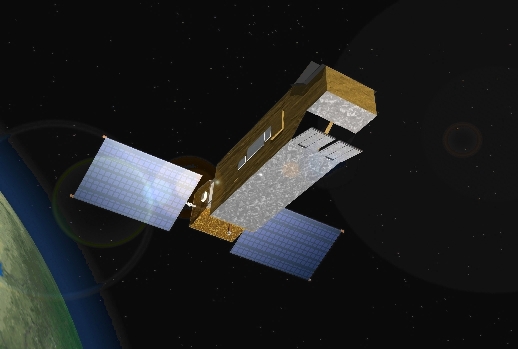

Mission Status Report #68 Star Date: May 14, 2003
FUSE "Brain Transplant" Effectively Complete!Caption: Graphic showing how FUSE would look on-orbit. The telescopes are looking toward the upper right in this picture, and only two of the four telescope doors are visible from this angle. The blue rectangles represent the solar panels, which connect to the spacecraft at the bottom. (Figure courtesy NASA and the FUSE project.)
A revised flight software load to FUSE began on April 16, 2003, as reported in a previous status report. As of this writing, the "brain trasplant" is effectively complete, and FUSE is now back performing science observations full time. You may recall from previous reports that the project felt the need to protect itself from potential future failures of gyros onboard the satellite, which help FUSE maintain stable pointing and move from place to place on the sky. The new flight software is very clever, using whatever gyros are present and operating, but gracefully compensating for any missing gyros. Basically, as gyros fail, we will just keep operating. The new system will operate well as long as ANY gyros remain operational, and will still operate at acceptable levels even if we ever encounter a situation where we have NO gyros. (This is expected to be many years down the road, however, and may never affect FUSE operations.) To accomplish this feat, we have loaded new flight software to all three computers on board: the Attitude Control System computer in the spacecraft, the Instrument Data System computer in the science instrument, and the Fine Error Sensor (guide camera) processor. Collectively, these processors constitute the "brain" of the satellite, so this process has been somewhat like performing a "brain transplant" on FUSE while it is in orbit! As with any such major surgery, there has been a period of recovery, but the patient is doing remarkably well. We are not only walking, but running again in full speed! Special thanks to all the scientists and engineers at JHU, on the Mission Operations Team, and at Orbital Sciences Corporation who have supported not only the development and testing, but now the implementation and on-orbit checkout of this new flight software system.
Reported by: Bill Blair, Chief of Observatory Operations
|
